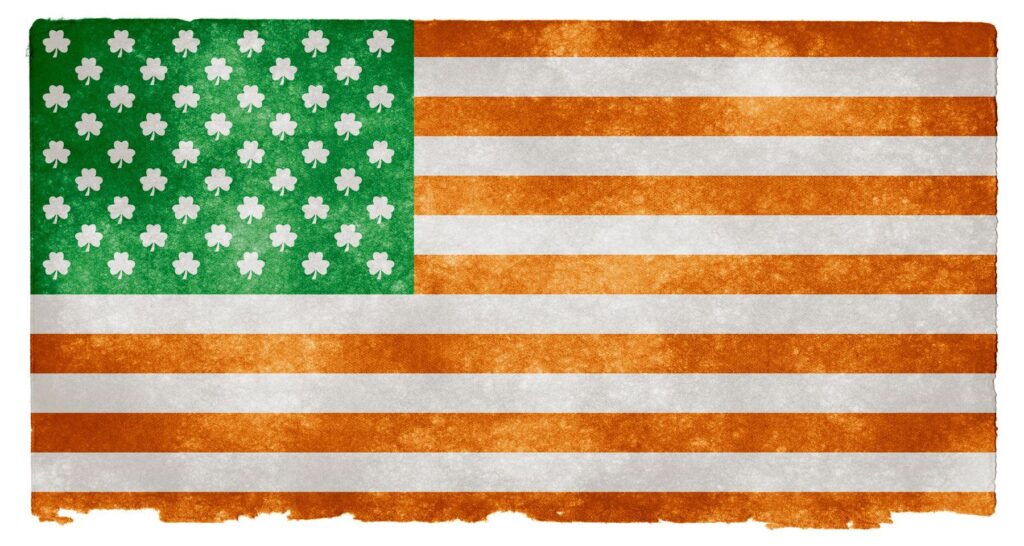
Image source Irish American Flag Wallpaper
St. Brendan of Ardfert and Clonfert, is also dubbed Brendan the Voyager. He was born in Ciarraighe Luachra, near Tralee, in the south west of Ireland, in 484. His parents were Finnlug and Cara. He was baptized at Tobar na Molt holy well, near Ardfert, by Bishop Erc of Slane. He was catechised by St. Ita of Killeedy in Limerick, who ran a boarding school for future clerics. After this, Brendan studied under Bishop Erc, mastering the scriptures. St. Brendan was also disciple of St. Enda of Inishmore. He was further tutored by an angel who gave him the rule of St. Brendan. It was around this time he became ordained a priest in 512 by bishop Erc. Brendan developled an ascetic hermitage style of life. Between the years 512 and 530 he built monastic cells at Ardfert, and at Shanakeel or Baalynevinoorach, at the foot of Brandon Hill.
At Brandon Hill, Brendan first lived the life of hermit by the coast, but soon a religious community formed around him, living under his rule. They would be a band of brothers becoming familiar with the sea, its weather patterns, and became accustomed to the frequent sun sets. From contemplating these patterns, Brendan decided to build a boat, in the Irish fashion of that time. It was a coracle with wooden frame and animal skin stretched over it. Tradition tells us he set sail with many monks. There is a Latin version of his sea voyage that speaks of one boat and eighteen monks. The oldest account of Brendan’s voyage is found in Latin, “Navigatio Sancti Brendani”. He set sail in search of Paradise with a company of monks. Additionally, the old Irish Calendars assigned a special feast for the “Egressio familiae S. Brendani”, on 22 March. We also learn from the book of Lismore that Brendan set sail with others on the 22nd of March. This has been translated into French, English, German and Dutch. From the Latin version, “Navigatio Sancti Brendani”, Christopher Columbus was encouraged that there might just be something out there worth investigating.
These accounts recount the adventures. For example; during the seven year sea voyage, the monks witnessed the sea at its best as well as times when it might threaten to swallow them up. They would witness the many large sea creatures showing their presence. It was a strange & frightful world for the monks to witness. The monks were also tested along their ocean voyage. One particular test was a time, they landed on this strange island somewhere in the Atlantic, but St. Brendan remained on the boat. He had an inkling there was something not quite right. The monks got out of the boat looking to lit a fire to cook food on the island. They lit a small fire and then they felt a sudden earth quake. It turned out they landed on the top of Jessconius the largest of the ocean fish. When Jessconius suddenly began submerging, the monks found themselves swimming back quickly to the boat. Brendan remained calm as his monks made it back to safety. It was there he was able to explain what exactly happened when they lit the fire.
Whenever the monks were afraid, Brendan would encourage them with spiritual advice. He told them not to be afraid of the large sea creatures, as our life span is in the hands of God. Brendan would celebrate Mass on the boat, and the sea creatures would circle the boat as if to participate in some way at the Mass. In this way Brendan demonstrated the power of God over His creatures.
After a long voyage that lasted seven years they reached the “Terra Repromissionis”, or the promised land, a most beautiful land with luxuriant vegetation. Through St. Brendan’s ocean voyage, many scholars claim for the Irish the glory of discovering America; namely, MacCarthy, Rafn, Beamish, O’Hanlon, Beauvois, Gafarel, etc. They rest there claim on the account of the Northmen who found a region south of Vinland and the Chesapeake Bay called “Hvitramamaland” (Land of the White Men) or “Irland ed mikla” (Greater Ireland), and on the tradition of the Shawano (Shawnee) Indians that in earlier times Florida was inhabited by a white tribe which had iron implements.
In the 70s, Tim Severin and a team of explorers built themselves a replica of the Irish currach, and sailed across the Atlantic to Newfoundland from the Irish coast, making several stops en route. They proved the plausibility that St. Brendan could have done the same! Additionally, during their voyage Severin’s crew identified some “mystical” objects described in the accounts in Brendan’s voyage; such as “the island of sheep”, “the crystal towers” (glaciers and icebergs on the northern islands), “the mountains that hurled rocks” (volcanoes in Iceland), “sea monsters” (whales, porpoises and probably walruses).
For these reasons we celebrate the Stars & Strips of St. Brendan, land of the spiritually free! So we now ask the question, did Brendan really discover the promised land. In God we trust!
St. Brendan died at Enachduin, (Annaghdown) in 577. He was interred in Clonfert, and his feast is kept on 16 May.